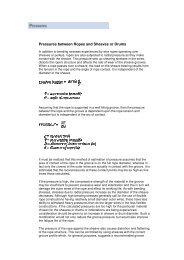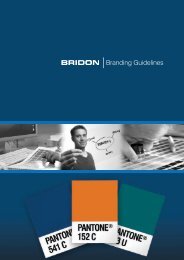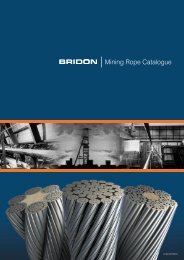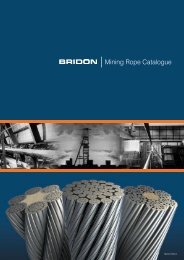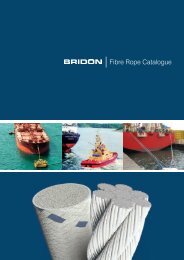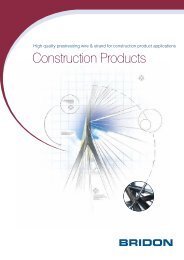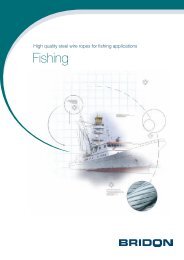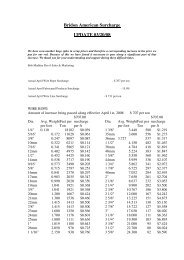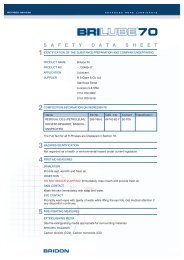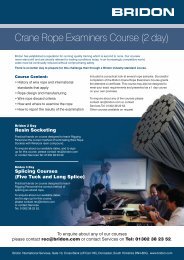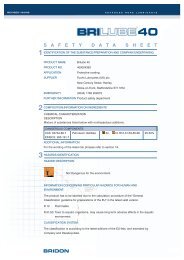Bridon - Teyseer Group
Bridon - Teyseer Group
Bridon - Teyseer Group
You also want an ePaper? Increase the reach of your titles
YUMPU automatically turns print PDFs into web optimized ePapers that Google loves.
Troubleshooting GuideThe following is a simplified guide to common wire rope problems. In the event of no other standard being applicable,<strong>Bridon</strong> recommends that ropes are inspected/examined in accordance with ASME B30.5.problemMechanical damage caused by the rope contacting the structure of thecrane on which it is operating or an external structure — usually of alocalized nature.Cause/Action• Generally results from operational conditions.• Check sheave guards and support/guide sheaves to ensure that the rope has not“jumped out” of the intended reeving system.• Review operating conditions.• Check sheave and drum groove radii using sheave gauge to ensure that they are nosmaller than nominal rope radius +2.5%. <strong>Bridon</strong> recommends that the sheave anddrum groove radii are checked prior to any rope installation.• Repair or replace drum/sheaves if necessary.Opening of strands in rotation-resistant ropes — in extreme circumstances therope may develop a “birdcage distortion” or protrusion of inner strands.Note — rotation-resistant ropes are designed with a specific strand gap whichmay be apparent on delivery in an off tension condition. These gaps will closeunder load and will have no effect on the operational performance of the rope.• Check fleet angles in the reeving system — a fleet angle in excess of 1.5 degreesmay cause distortion (see page 56).• Check installation method — turn induced during installation can cause excessiverope rotation resulting in distortion (see pages 55 to 58).• Check if the rope has been cut on site prior to installation or cut to remove adamaged portion from the end of the rope. If so, was the correct cutting procedureused? Incorrect cutting of rotation-resistant, low-rotation and parallel closed ropescan cause distortion in operation (see page 56 to 57).• Rope may have experienced a shock load.Broken wires or crushed or flattened rope on lower layers at crossover pointsin multi-layer coiling situations.Wire breaks usually resulting from crushing or abrasion.• Check tension on underlying layers. <strong>Bridon</strong> recommends an installation tension ofbetween 2% and 5% of the minimum breaking force of the wire rope. Care shouldbe taken to ensure that tension is retained in service. Insufficient tension will result inthese lower layers being more prone to crushing damage.• Review wire rope construction. Dyform wire ropes are more resistant to crushing onunderlying layers than conventional rope constructions.• Do not use more rope than necessary.• Check drum diameter. Insufficient bending ratio increases tread pressure.• Insufficient service dressing.• Consider alternative rope construction.Wires looping from strands.• If wires are looping out of the rope underneath a crossover point, there may beinsufficient tension on the lower wraps on the drum.• Check for areas of rope crushing or distortion.• Possible fleet angle problems causing rope rotation.“pigtail” or severe spiralling in rope.• Check that the sheave and drum diameter is large enough. <strong>Bridon</strong> recommends aminimum ratio of the drum/sheave to nominal rope diameter of 18:1.• Indicates that the rope has run over a small radius or sharp edge.• Check to see if the rope has “jumped off” a sheave and has run over a shaft.50 BRIDON North American Catalog



